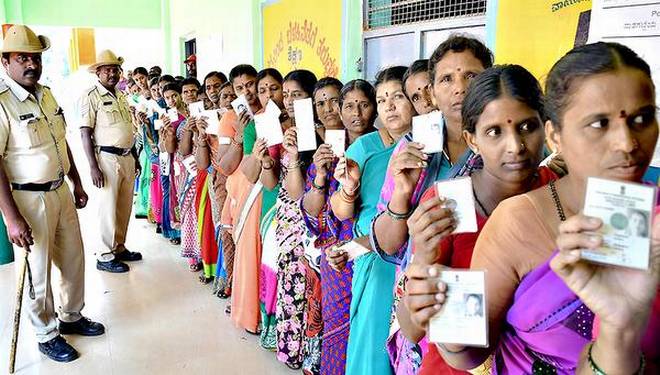Karnataka elections 2018 – Verdict is out
May 15, 2018 | Expert Insights

The Bharatiya Janata Party (BJP) has emerged as the single largest winner in the Karanataka elections, securing 104 out of the 222 assembly seats - according to results that were announced today. In a highly polarized campaign, the Indian National Congress (INC) won 78 and the Janata Dal (JD) 38 seats. Independents court victory in two seats.
Background
Post Independence, the Karnataka Legislative Assembly elections are held once every five years. The first legislative elections took place in 1952. The assembly elections are held to choose members of the Vidhan Sabha (legislative/state assembly). Those who get elected are then called MLAs.
The southern Indian state of Karnataka took its present shape in 1956, after the states of Mysore and Coorg (Kodagu) merged with the Kannada-speaking districts of the former states of Bombay and Hyderabad, and Madras. Mysore state was made up of 10 districts: Bangalore, Kolar, Tumkur, Mandya, Mysore, Hassan, Chikmagalur (Kadur), Shimoga, and Chitradurga. The first ever assembly election in Karnataka was held in 1952 and it resulted in a victory for the Indian National Congress. K. Chengalaraya Reddy became the first ever chief minister of the state.
The Government of Karnataka is a democratically elected body with the governor as the constitutional head. The governor is appointed for five years and appoints the chief minister and his council of ministers. The governor remains the head of the state, but the day-to-day functioning is undertaken by the chief minister and his council of ministers. The politics of Karnataka is dominated by three major political parties, the Indian National Congress, the Janata Dal (Secular), and the Bharatiya Janata Party (BJP). The Indian National Congress has been in power in the state since May 2013. Siddaramaiah is the current chief minister.
There are 224 seats in the Karnataka Legislative Assembly. For a party to declare majority and form a government, it has to win at least 113 seats either by itself or through a coalition. For administrative purposes, Karnataka has been divided into four revenue divisions, 49 sub-divisions, and 30 districts. The state has 281 towns and 7 municipal corporations. Bangalore is the fifth largest urban city out of 23 metropolises in India. It is among the fastest growing cities in the world.
Analysis
As the Karnataka election were declared, the Congress reached out to former Prime Minister Deve Gowda’s JD(S) on Tuesday to keep the BJP out of power in the southern state that registered a voter turnout of more than 72% on May 12. The leaders from the BJP and JD(S) independently met Karnataka Governor Vajubhai Vala to stake their claim of forming the government.
Prime Minister Narendra Modi took to Twitter to thank people of Karnataka for making the BJP the single largest party in the state. “I thank my sisters and brothers of Karnataka for steadfastly supporting the BJP’s development agenda and making BJP the single largest party in the state. I salute the stupendous work of @BJP4Karnataka Karyakartas who toiled round the clock and worked for the party,” the PM tweeted.
JD(S) leader Kumaraswamy and Congress leader Siddaramaiah addressed the media after meeting the governor. “Congress has given unconditional support to JD(S). JD(S) will form government with the help of Congress. Have informed the governor about our decision,” said Siddaramaiah. “The law is clear in this. In democracy, the largest number has to be given power. We have the numbers - 111, along with the JD(S) and two independents,” he added.
The BJP Parliamentary Board will meet at 7 p.m. at party headquarters in New Delhi today.
“As we will be the single largest party in the 224-member assembly, we will stake the claim to form the government. By precedence, the governor is bound to call us to explore government formation even if we fall short of the halfway mark (113),” BJP state unit spokesman S. Shantaram told IANS. “We are open to JD(S) support, if need be, after all the results are declared. Our approach to JD(S) will depend on the number of legislators we need to prove majority in the house or win the confidence motion,” the BJP state unit spokesman added.
Meanwhile, the Karnataka chief minister Siddaramaiah submitted his resignation to the Governor. Siddaramaiah earlier said that the Congress accepts the verdict in the Karnataka elections, and will support the JD(S) to form a government.
In their first public appearance with Ghulam Nabi Azad and Siddaramaiah, Congress leader G. Parameshwara said, “We accept the mandate of the people. We bow our heads to the verdict. We don’t have numbers to form government. The Congress has offered to support JD(S) to form govt.”
Shiv Sena chief Uddhav Thackeray reacted to BJP’s performance, “Just one time, I want BJP to head into elections with ballot papers and not EVMs. All the apprehensions will go away.”
Assessment
Our assessment is that the BJP’s triumph represents a certain continuation of a three-and-a half decade trend in Karnataka’s politics. Since 1983, the state has witnessed regular alternation of power. We believe that the high decibel campaign by the Prime Minister did significantly dent Congress prospects. We also believe that the Prime Minister’s rallies did make the difference and provided the final push that the BJP needed to cross the 100 marks. The Congress was not able make it, despite the mega welfare schemes that the Chief Minister had launched. They also could not consolidate the Dalit community in their favour. It also appears that the move by the Congress to propose reservation for the Lingayats did not give them significant electoral dividends.
Read more: Karnataka elections








Comments